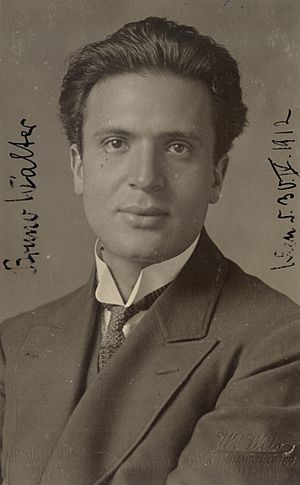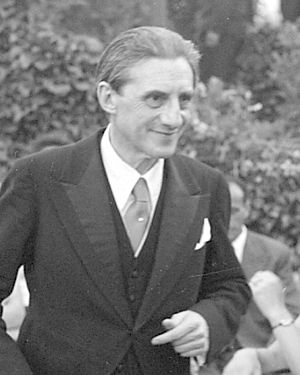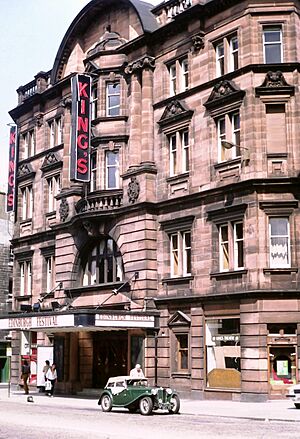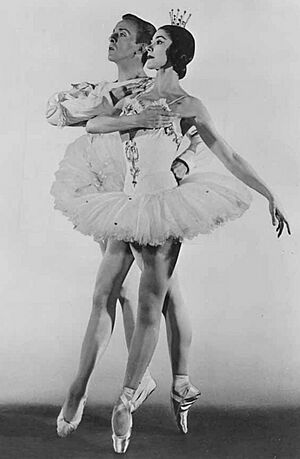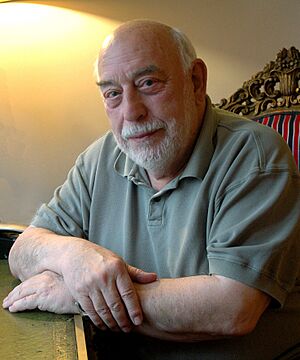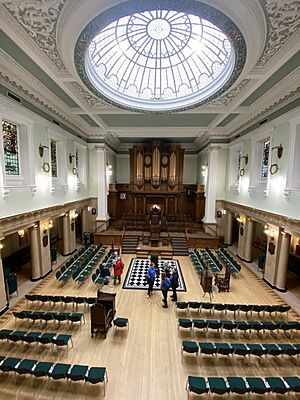Edinburgh International Festival facts for kids
Quick facts for kids Edinburgh International Festival |
|
|---|---|
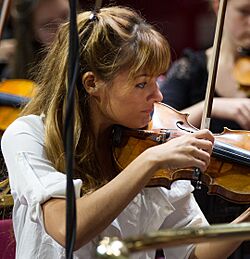
Nicola Benedetti, Director of the Edinburgh International Festival from 2023
|
|
| Date(s) | 2024: 5–28 August (exact dates vary each year) |
| Frequency | Annual |
| Location(s) | Edinburgh, Scotland |
| Inaugurated | 1947 |
| Patron(s) | Queen Elizabeth The Queen Mother (1947–1952) Queen Elizabeth II (1952–2017) Prince Edward (2017–present) |
The Edinburgh International Festival is a big yearly arts celebration in Edinburgh, Scotland. It happens for three weeks in August. Famous artists from around the world are invited to share their music, dance, and theatre. You can also see art shows, listen to talks, and join workshops.
The very first festival, called the 'International Festival of Music and Drama,' took place from August 22 to September 11, 1947. Its first director was Rudolf Bing. The festival has happened every year since then, except in 2020 when it was cancelled because of the COVID-19 pandemic. A smaller version of the festival was held in 2021.
Contents
Festival Leaders Through the Years
The festival has had many different directors who helped shape its program:
- 1947–1949: Sir Rudolf Bing, an opera expert from Austria.
- 1950–1955: Sir Ian Hunter, a British classical music organizer.
- 1956–1960: Robert Ponsonby, a British music manager.
- 1961–1965: George Lascelles, 7th Earl of Harewood, a British opera manager.
- 1966–1978: Peter Diamand, an arts manager born in Berlin.
- 1979–1983: Sir John Drummond, a British arts manager.
- 1984–1991: Frank Dunlop, a British theatre director.
- 1992–2006: Sir Brian McMaster, a British arts manager.
- October 2006–2014: Sir Jonathan Mills, an Australian composer.
- October 2014–2022: Fergus Linehan, an Irish theatre and music producer.
- October 2022–: Nicola Benedetti, a Scottish-Italian violinist.
How the Festival Began
The idea for the festival came after World War II. People wanted to create a place for art to help heal the world. They hoped it would make Scotland, Britain, and Europe richer in culture.
The main idea came from Rudolf Bing, who managed the Glyndebourne Opera Festival. He worked with Lady Rosebery, theatre director Sir Tyrone Guthrie, and Audrey Mildmay. They thought of the festival during a wartime tour of an opera show.
Rudolf Bing wanted the festival to use art to fix the problems caused by the war. This was the main reason it started. The festival was first funded by Lord Rosebery. He used £10,000 he won from his horse, Ocean Swell, in a race. The Edinburgh Town Council matched this money. Then, the Arts Council of Great Britain also added funds.
Bing also worked with Henry Harvey Wood from the British Council in Scotland, Sidney Newman from Edinburgh University, and local leaders like Sir John Falconer.
Bing had looked at other cities in England before choosing Edinburgh. He had visited Edinburgh in 1939 and liked it. Edinburgh Castle reminded him of Salzburg, where he had directed a festival before the war.
Henry Harvey Wood described how the idea came about:
The Edinburgh International Festival of Music and Drama was first discussed over a lunch table in a restaurant in Hanover Square, London, towards the end of 1944. Rudolf Bing, convinced that musical and operatic festivals on anything like the pre-war scale were unlikely to be held in any of the shattered and impoverished centres for many years to come, was anxious to consider and investigate the possibility of staging such a Festival somewhere in the United Kingdom in the summer of 1946. He was convinced and he convinced my colleagues and myself that such an enterprise, successfully conducted, might at this moment of European time, be of more than temporary significance and might establish in Britain a centre of world resort for lovers of music, drama, opera, ballet and the graphic arts.
Certain preconditions were obviously required of such a centre. It should be a town of reasonable size, capable of absorbing and entertaining anything between 50,000 and 150,000 visitors over a period of three weeks to a month. It should, like Salzburg, have considerable scenic and picturesque appeal and it should be set in a country likely to be attractive to tourists and foreign visitors. It should have sufficient number of theatres, concert halls and open spaces for the adequate staging of a programme of an ambitious and varied character. Above all it should be a city likely to embrace the opportunity and willing to make the festival a major preoccupation not only in the City Chambers but in the heart and home of every citizen, however modest. Greatly daring but not without confidence I recommended Edinburgh as the centre and promised to make preliminary investigations.
Wood talked to Falconer, who was very excited about the idea for Edinburgh. It was too late to plan for 1946, so they aimed for the next year.
What You Can See at the Festival
The first festival ran from August 22 to September 11, 1947. For many years, it stretched into September. But in 2015, the dates changed so it would start and end in August. This made it line up with the Edinburgh Festival Fringe, which had changed its dates earlier.
Classical Music Performances
From the very start, classical music was a big part of the festival. A highlight of the first year was concerts by the Vienna Philharmonic orchestra. They reunited with their conductor Bruno Walter, who had left Europe in 1938.
Many famous musicians played at the festival in the early years. These included conductors like Wilhelm Furtwängler and John Barbirolli. Pianists like Artur Schnabel and violinists like Joseph Szigeti also performed.
Rising stars of the time also came to Edinburgh. These included conductors like Herbert von Karajan and Leonard Bernstein. Pianists like Claudio Arrau and string players like Yehudi Menuhin were also there.
Even more great artists came in later decades. Conductors like Otto Klemperer and Georg Solti performed. Later, artists like Pierre Boulez, Claudio Abbado, and Daniel Barenboim (who also played piano) appeared. Famous soloists included pianists Alfred Brendel and Marta Argerich. Cellist Jacqueline du Pré and violinist Itzhak Perlman also played.
Opera Shows
Glyndebourne Opera was very involved in starting the Edinburgh Festival. Because of this, opera was always an important part of the program.
Edinburgh didn't have special places to create new opera shows. So, guest companies were invited to perform. In the early years, Glyndebourne brought two shows each year. Later, companies like Hamburg and La Scala came.
Over the years, many different opera companies visited. These included the Stuttgart State Opera and the Royal Opera Stockholm. From 1965, the Edinburgh Festival Opera also started putting on local shows.
Big names in opera came to Edinburgh. Conductors like Claudio Abbado and Georg Solti led performances. Directors like Franco Zeffirelli also worked on shows.
Star singers included Maria Callas, Joan Sutherland, and Luciano Pavarotti. These famous voices made the opera shows very special.
Ballet Performances
Ballet started at the festival with performances of The Sleeping Beauty. Margot Fonteyn and Robert Helpmann danced with the Sadler's Wells Ballet Company. They came back in later years.
Other ballet companies also performed. These included Ballets des Champs-Élysées from Paris and American National Ballet Theatre from New York. The Royal Danish Ballet also brought their shows.
Drama and Theatre
Drama was a key part of the Edinburgh International Festival from the very beginning.
The Old Vic Theatre Company strongly supported the festival early on. Over the years, other important British companies joined them. These included the Royal Shakespeare Company and the National Theatre of Great Britain.
One of the festival's first big theatre successes was in 1948. An old play called The Thrie Estaites was performed. It was the first time it had been seen since 1552! This play was so popular it was brought back many times.
Theatre groups came from all over the world. In the early years, they came from France, Italy, and Canada. Later, groups from Greece, Russia, Poland, the USA, and Japan also performed. Famous groups included Le Comédie Française and the Abbey Theatre Dublin.
Well-known actors also appeared. These included Ralph Richardson, Alec Guinness, and John Gielgud. Later, actors like Ian McKellen and Timothy West performed.
Visual Arts Exhibitions
Visual arts, like paintings and sculptures, were added to the festival in 1949. They quickly became an important part of the events. Major art shows were held at the National Gallery of Scotland and Royal Scottish Academy.
These exhibitions featured famous artists. In the early years, there were shows of Rembrandt, El Greco, Degas, and Renoir. Later, art by Monet, Cézanne, and Picasso was shown.
The festival continued to bring art from around the world. There were shows of Byzantine Art, German Expressionist Painting, and Modern Primitive Paintings from Yugoslavia. Exhibitions also focused on artists like Matisse and Modigliani.
World Premieres
Many new works have been shown for the very first time at the Edinburgh International Festival. For example, T. S. Eliot's plays The Cocktail Party (1949) and The Confidential Clerk (1953) had their first performances here. More recently, James MacMillan's Quickening (2018 version) and his Symphony No. 5 (2019) also premiered at the festival.
Festival Locations
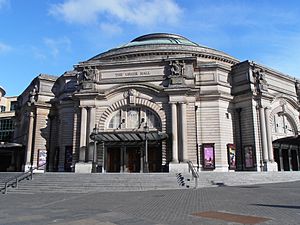
The main places where the festival events happen are:
- Usher Hall: A large concert hall built in 1914. The festival has used it since 1947.
- Kings Theatre: Opened in 1906, used for theatre and opera since 1947. It is currently closed for updates.
- Royal Lyceum Theatre: Opened in 1883, used for drama since 1947.
- The Edinburgh Playhouse: Opened in 1929, it's Britain's largest theatre.
- Festival Theatre: Dates back to 1892. It was first used for ballet by the festival in 1947. It was updated in 1994 and now hosts opera and ballet.
- The Queen's Hall: A converted chapel that became a concert hall in 1979. It's home to the Scottish Chamber Orchestra.
- The Hub: This building was originally a church from 1842-44. It's now the main ticket office and information center for the festival. It also has its own performance space. Its tall spire is the highest point in central Edinburgh outside the Castle.
- The Dunard Centre: A new concert hall that is expected to open in 2024 or 2025.
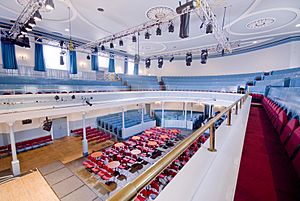
Other places that have been used for the festival in the past include:
- Church Hill Theatre: Built in 1892 as a church, bought by the city in 1960.
- Freemasons' Hall: Opened in 1912, used for concerts from 1947.
- General Assembly Hall of the Church of Scotland: Used for drama shows from 1949.
- Leith Theatre: Used for concerts from 1961 to the late 1970s. It is now being restored.
- St Cecilia's Hall: A historic concert hall from 1763.
Other Festivals in Edinburgh
Around ten other festivals happen in Edinburgh at the same time as the International Festival. Together, they are known as the Edinburgh Festivals.
The most famous is the Edinburgh Festival Fringe. It started as a smaller event alongside the International Festival in its first year. Now, it's the world's largest arts and media festival!
The Edinburgh International Film Festival also began in August 1947, showing documentary films. In the 1990s, this festival moved to June. The Edinburgh International Book Festival also takes place in August.
The British Army wanted to show off during the festival. This led to the first Edinburgh Military Tattoo in 1950. It features piping and dancing. This yearly event is now seen as part of the official festival, even though it's organized separately.
All these festivals together mean there are over 2,500 performances and events every day in Edinburgh in August. It's much bigger than any other group of arts festivals in the world!
See also
 In Spanish: Festival de Edimburgo para niños
In Spanish: Festival de Edimburgo para niños
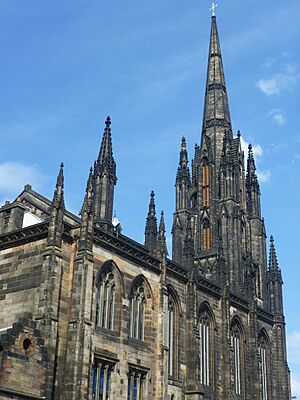
- List of Edinburgh festivals
- List of opera festivals
- Edinburgh Festival Fringe 1947
External links
- Edinburgh Festival City Guide to 10 festivals
- Listings and reviews at The List
- ThreeWeeks a guide to the Edinburgh Festival
- A History of the Edinburgh Festivals
- National Library of Scotland: SCOTTISH SCREEN ARCHIVE (selection of archive films about the Edinburgh Festival)
hu:Edinburgh-i Fesztivál


